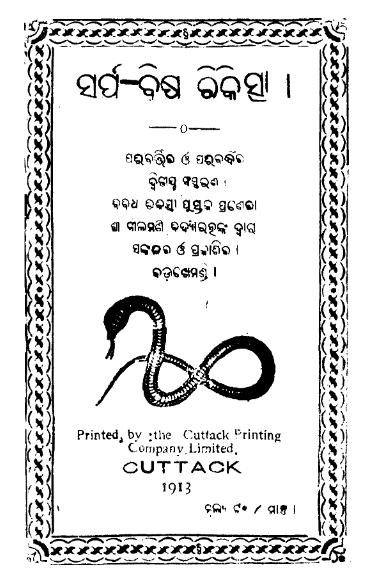In the annals of Odia literature, the year 1913 marked the publication of a noteworthy book that would inform and educate its readers about the world of herbal medicine and toxins—Sarpabisa Chikitsa by Nilamani Bidyaratna. This seminal work, which translates to Treatment of Snake Venom, serves not only as a compendium of general knowledge regarding snake bites and their treatment but also as a reflection of traditional healing practices prevalent in Odisha and beyond.
Nilamani Bidyaratna, a scholar steeped in the traditional medical knowledge of his time, aimed to equip readers with valuable insights into the realm of snake venom, its effects, and various remedies. The book is structured to introduce readers to the biology of snakes, highlighting the diversity of species and the specifics of their venoms. It meticulously details the physiological effects of different types of snake bites, making it an essential reference for anyone interested in toxicology or herbal medicine.
One of the book’s notable features is its blend of scientific inquiry with traditional wisdom. Bidyaratna approaches the subject with a respect for local knowledge systems, integrating folk remedies and herbal treatments alongside more conventional medical practices. This dual approach not only enriches the reader’s understanding but also underscores the importance of cultural heritage in medicine. The use of indigenous plants and preparations, extensively documented in Sarpabisa Chikitsa, exemplifies how traditional practices can complement contemporary knowledge.
The text is richly informative, providing readers with practical guidance on how to identify snake species common to the region and the corresponding symptoms of their bites. Bidyaratna emphasizes the importance of swift action in the face of a snake bite, offering detailed instructions on first aid measures and the use of herbal antidotes. This pragmatic orientation makes Sarpabisa Chikitsa not only a theoretical resource but also a practical handbook for individuals living in snake-prone areas.
Moreover, Sarpabisa Chikitsa reflects the broader socio-cultural context of early 20th-century Odisha, where interactions between traditional medicine and emerging modern healthcare practices were beginning to take shape. The book serves as a bridge between ancient healing traditions and contemporary medical practices, emphasizing the need for holistic approaches in health care.
The language of Sarpabisa Chikitsa is another point of interest. Written in Odia, the text showcases the richness of the language while making complex topics accessible to a wider audience. Bidyaratna’s commitment to using the local vernacular not only promotes literacy but also strengthens regional pride in Odia culture and knowledge systems.
Despite being over a century old, the insights contained within Sarpabisa Chikitsa remain relevant today. In a world where natural remedies are experiencing a resurgence in popularity, Bidyaratna’s work serves as a reminder of the value of integrating traditional knowledge with modern science. It encourages readers to explore their natural surroundings, fostering an appreciation for the healing potential of local flora.
Books Info
| Books name | Sarpabisa Chikitsa / ସର୍ପବିଷ ଚିକିତ୍ସା |
| Author | Nilamani Bidyaratna |
| No Of pages | 18 |
| Publisher | NA |
| Publication | 1913 |
| Printed At | The Cuttack Printing Company Ltd. |
| Distributor | NA |

